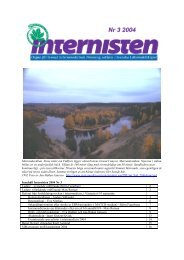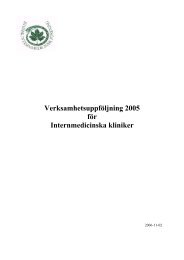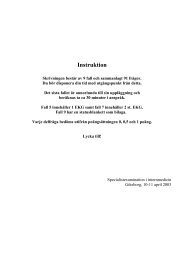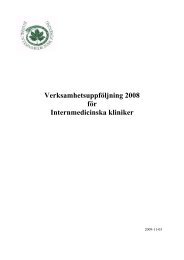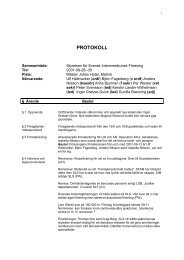Instruktion
Instruktion
Instruktion
Create successful ePaper yourself
Turn your PDF publications into a flip-book with our unique Google optimized e-Paper software.
1350 THE NEW ENGLAND JOURNAL OF MEDICINE May 23, 1996<br />
carvedilol while recognizing its potential to prolong<br />
life, demonstrated by the results of experimental stud-<br />
7,8,21 ies. Carvedilol is a nonselective b-receptor<br />
antagonist<br />
that also blocks a1-receptors<br />
and, unlike other<br />
beta-blockers, exerts antioxidant effects, which may<br />
22-24<br />
contribute to its actions in heart failure. This report<br />
summarizes the effects of carvedilol on survival and on<br />
hospitalization for cardiovascular causes.<br />
Study Patients<br />
METHODS<br />
All patients in the study had had symptoms of heart failure for at<br />
least three months and had ejection fractions 0.35,<br />
despite at least<br />
two months of treatment with diuretics and an angiotensin-converting–enzyme<br />
inhibitor (if tolerated); treatment with digoxin, hydralazine,<br />
or nitrates was permitted but not required. Patients were excluded<br />
from the trial if they had had a major cardiovascular event<br />
or had undergone a major surgical procedure within three months of<br />
entry into the study, or if they had uncorrected, primary valvular disease;<br />
active myocarditis; sustained ventricular tachycardia or advanced<br />
heart block not controlled by antiarrhythmic intervention or<br />
a pacemaker; systolic blood pressure of more than 160 or less than<br />
85 mm Hg or diastolic blood pressure of more than 100 mm Hg; a<br />
heart rate of less than 68 beats per minute; clinically important hepatic<br />
or renal disease; or any condition other than heart failure that<br />
could limit exercise or survival. Patients receiving calcium-channel<br />
blockers, a-<br />
or b-adrenergic<br />
agonists or antagonists, or class IC or<br />
III antiarrhythmic agents were also not enrolled. The protocol was<br />
approved by the institutional review boards of all 65 participating institutions;<br />
written informed consent was obtained from all patients.<br />
Study Procedures<br />
The patients’ eligibility was assessed during a three-week screening<br />
period, during which exercise capacity was measured by a sixminute<br />
corridor-walk test. Enrollment was stratified into one of four<br />
treatment protocols on the basis of the patients’ performance on the<br />
exercise test. According to the original design, patients able to walk<br />
between 426 and 550 m when tested were assigned to the mild-heartfailure<br />
protocol; those able to walk between 150 and 425 m were assigned<br />
either to the moderate-heart-failure protocol or to a dose-ranging<br />
protocol, depending on the location of the study center; and those<br />
able to walk only less than 150 m were assigned to the severe-heartfailure<br />
protocol.<br />
After a base-line evaluation, all patients received 6.25 mg of<br />
carvedilol twice daily for two weeks (the open-label portion of the<br />
study); if this dose was not tolerated, it could be temporarily reduced<br />
to 3.125 mg twice daily and then later increased. Patients who could<br />
tolerate 6.25 mg twice daily were randomly assigned to receive<br />
carvedilol or placebo on a double-blind basis, in addition to their usual<br />
medication. The allocation ratio (of patients given carvedilol to patients<br />
given placebo) was one-to-one in the moderate-heart-failure<br />
protocol and two-to-one in the mild- and severe-heart-failure protocols;<br />
for these patients, the dose of medication was initially 12.5 mg<br />
twice daily and was increased, if tolerated, to 25 to 50 mg twice daily.<br />
Patients assigned to the dose-ranging protocol were randomly assigned<br />
to one of four parallel treatment groups (placebo or 6.25 mg,<br />
12.5 mg, or 25 mg of carvedilol, twice daily). For all four protocols,<br />
the dose was gradually adjusted upward to the target level over a period<br />
of 2 to 10 weeks, after which double-blind therapy was maintained<br />
for an additional 6 months (except in the mild-heart-failure<br />
protocol, in which patients were treated for an additional 12 months).<br />
During this time, the patients’ other drug therapies for heart failure<br />
were kept constant, unless side effects occurred that were thought to<br />
be related either to these other medications or to the study drug itself.<br />
Study Objectives and Monitoring<br />
Because of concern that new drugs for heart failure might increase<br />
the risk of death, the sponsors of the program agreed with the Food<br />
and Drug Administration in July 1992 to enroll a sufficient number of<br />
CAPS:CAPS Shipped Pages:may23.96:1pack.oa<br />
Wed May 22 96 12:04:56<br />
patients in placebo-controlled trials of carvedilol to rule out (with 95<br />
percent confidence) the risk of a 33 percent increase in mortality with<br />
active therapy, assuming an annual mortality rate of 12 percent in the<br />
placebo group. As a result of these discussions, an evaluation of mortality<br />
was prospectively defined for the present stratified trial program,<br />
primarily for reasons of safety, with the intent to enroll 1101<br />
patients. However, since it was anticipated (on the basis of earlier<br />
studies) that carvedilol could reduce mortality, all statistical analyses<br />
were two-sided. All deaths were classified by investigators who had no<br />
knowledge of the patients’ treatment assignments. In addition, a major<br />
secondary objective of each of the component protocols was to<br />
evaluate the effect of carvedilol on cardiovascular morbidity, defined<br />
as hospitalization for heart failure or other cardiovascular causes.<br />
A data and safety monitoring board was constituted before recruitment<br />
began, met periodically to review the unblinded results, and was<br />
empowered to recommend early termination of the program if its<br />
members observed a clinically important treatment effect. No formal<br />
rules for stopping the trial were adopted before the initiation of enrollment.<br />
Statistical Analysis<br />
The base-line characteristics of the two treatment groups were<br />
compared with use of the t-test and the chi-square statistic. Cumulative<br />
survival curves were constructed as time-to-first-event plots by<br />
25<br />
Kaplan–Meier survivorship methods, and differences between the<br />
curves were tested for significance by the log-rank statistic with use<br />
of a Cox proportional-hazards regression model (which included the<br />
protocol as a covariate).<br />
26<br />
The analyses included all randomized pa-<br />
tients, and all events were assigned to the patients’ original treatment<br />
group (on the intention-to-treat principle). In the analysis of mortality,<br />
data on patients were censored at the time of cardiac transplantation.<br />
Differences between treatment groups in post-randomization<br />
measures or events were evaluated by analysis of variance and with<br />
the chi-square statistic. All data are reported as means SD.<br />
RESULTS<br />
Randomization began on April 29, 1993, and the study<br />
was stopped early on the recommendation of the Data<br />
and Safety Monitoring Board on February 3, 1995. This<br />
decision was based on the finding of a significant effect<br />
of carvedilol on survival — an effect that exceeded all<br />
conventional boundaries used to stop clinical trials.<br />
27,28<br />
At the time of the study’s early termination, 1197 patients<br />
had entered the open-label, run-in period. Of<br />
these, 5.6 percent failed to complete this period because<br />
of adverse events (e.g., worsening heart failure in<br />
1.4 percent and death in 0.6 percent); another 3.0 percent<br />
failed to do so because of violations of the protocol<br />
or for other administrative reasons. Accordingly, 1094<br />
patients were randomly assigned to double-blind treatment:<br />
398 with placebo and 696 with carvedilol.<br />
The placebo and carvedilol groups were similar in all<br />
pretreatment characteristics (Table 1). After randomization<br />
and the adjustment of dosage, patients received<br />
a mean total daily dose of 4527<br />
mg of carvedilol or<br />
6024<br />
mg of placebo; these doses were maintained at<br />
similar levels throughout the study period. Eighty percent<br />
of the patients received target doses of the study<br />
drugs. The duration of therapy ranged from 1 day to<br />
15.1 months (median, 6.5 months). No patient was lost<br />
to follow-up with respect to mortality.<br />
Effect of Carvedilol on Survival<br />
In the intention-to-treat analysis, there were 31 deaths<br />
(7.8 percent) in the placebo group and 22 deaths (3.2



